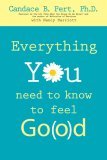I expected something different from Candace Pert’s latest book, Everything You Need to Know to Feel Go(o)d. For starters, the title’s a bit of a bait to the text’s switch. You aren’t going to find that promised Everything here. In fact, you aren’t going to find much, if any self helpy advicey stuff.

What you’re going to find, instead, are two other books. The one that takes up the most room is an autobiographical account of Pert’s efforts to deal with personal “issues” she’s realized have sabotaged her efforts to realize her vision of an AIDS cure. Pert and her husband, Michael Ruff, have pioneered research on peptides that block the receptors that permit the AIDS virus to enter cells (Pert’s a recognized experts in peptides and peptide receptors; as a graduate student in the 1970s, she proved the existence of opiate receptors). The original research they did was funded by the National Institute of Health; the two have been fighting for years, now, to wrest control of it from others who, for various reasons, have either quashed it or tried to leverage it for other, less compelling causes. This content is no doubt of interest to Pert’s fans, and will no doubt be a useful model to people struggling through parallel difficulties, but it’s not what I was looking for when I bought the book.
The other book got me excited. Unfortunately, it’s on the thin side: bits scattered here and there, primarily as summaries of presentations Pert has given over the last couple of years during her many public appearances.
The first bit peeks out at us right away, when Pert tells us she believes in something even more radical than “mind over matter. ” She believes that “mind becomes matter” — and that there is “real science” to support that assertion.
By sorting out the autobiographical diary-of-a-seeker stuff, one is able to find hints of that science. A big piece of it is that James Oschman (with whom Pert has collaborated on another book) has proposed “a physical structure in the body composed primarily of collagenous fibers, the kind that make up your connective tissue.” This structure, which Oschman calls “the matrix,” connects and penetrates every cell of the body, “a new understanding that flies in the face of the classical view of cells as empty little bags whose interior isn’t hooked up to existing structures.”
The significance of this structure, Pert writes, is that it’s “actually a semiconductor, a substance capable of supporting fast-paced, electrical activity . . . [I]n many ways, it’s like a giant liquid crystal.”
Apparently peptides — some of which we recognize as neurotransmitters that affect mood, e.g. serotonin — cause our cells to give off electrical signals which are transmitted by/across this structure. In other words, when we resonate with an emotion, we really are resonating. Furthermore, others around us can be affected by this resonance, rather like a tuning fork, rung, can cause another tuning fork to vibrate. You know the old quandary about how could a flock of birds sitting in a tree suddenly take off at once, as if they were one organism? Well, based on Pert seems to be saying, they are one organism: they are matrices within a greater matrix . As are the crowds of people at a concert or sporting event or political rally or church service.
Our body can also store charges — i.e., past emotional charges can be recorded by or imprinted in our bodies, causing us to essentially “lock in” to certain habitual ways of feeling or responding emotionally.
There are some other bits as well about the frequencies of music, color, and brain waves sharing identical wavelengths. Put it together and there’s the suggestion that, for example, our emotional response to music can be attributed the way the tones stimulate our cells’ neurotransmitter receptors. Wild. Wish there was more of that kind of stuff in the book.
